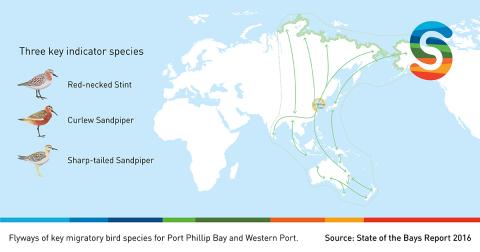
As part of our campaign to celebrate Victoria’s marine environment, this week we share some insights on marine-dependent birds in the ecosystems of Port Phillip Bay and Western Port from the State of the Bays (SotB) 2016 report. Information is available on the health of a range of waterbirds in Western Port – including fish-eating (piscivorous) birds – while the Port Phillip Bay analysis is restricted to roosting shorebirds. There is also a discussion of the little penguin colonies at Phillip Island and St Kilda.
BBC sports commentator narrates Australia's penguin parade in lockdown voiceover
In SotB 2016, we reported that in Port Phillip Bay, the red-necked stint, curlew sandpiper and sharp-tailed sandpiper are the three key species of roosting, migratory shorebirds – and that the roosting shorebirds were monitored at eight coastal sites. We found that the numbers of roosting shorebirds were declining in line with populations throughout the world over the past 20 years. The impact of sea level rise on tidal flats is probably an important pressure.
CES20_SotB_Campaign_Facebook_Week 103.jpg

In SotB 2016, we reported that the status of roosting shorebirds in Port Phillip Bay and water birds in Western Port is fair, while piscivorous birds in Western Port is good and little penguins in both bays is also good. Data quality for little penguins at St Kilda is poor, otherwise the available bird data was good.
At least 253 bird species have been recorded in Western Port, including 102 species of waterbird and 151 other species, including bush birds (passerines), raptors, cockatoos and parrots, pigeons, cuckoos and quail. Western Port regularly supports over 10,000 individual shorebirds and over 10,000 individual waterfowl. The area has considerable biodiversity and is recognised as a wetland of international importance under the Ramsar Convention (1971). In 2010, Western Port was also listed as an Important Bird Area as it is regularly home to a significant proportion of the global population of eastern curlew, red-necked stint and Australian pied oystercatcher. It also hosts declining numbers of two threatened species, the fairy tern and the orange-bellied parrot.
Calidris ruficollis: red-necked stint. Credit - Nick Talbot
The SotB 2016 identified significant knowledge gaps include improving Port Phillip Bay monitoring activities, to bring them into line with activities in Western Port, and integrating current bird research. Other gaps include understanding the impacts of fish food stocks on birds and improving the accuracy of penguin counts.
The SotB 2016 suggests that a better monitoring regime for the western shore of Port Phillip Bay is recommended and that the regime must better monitor birdlife activity, especially because most of the bay’s shoreline is a Ramsar site and/or an Important Bird and Biodiversity Area.
We invite you to head to our interactive State of the Bays website here and access the SotB 2016 report – the next iteration of the report will include an expanded scope and be titled the Victorian State of the Marine and Coastal Environment 2021 report – currently in preparation by the Commissioner for Environmental Sustainability. https://lnkd.in/gB5Z4ey
Quick fact
Did you know that Victoria is one of only two jurisdictions in Australia (the other being the ACT) with an independent Commissioner charged with periodic State of the Environment reporting? Read about Victoria’s Commissioner for Environmental Sustainability.
